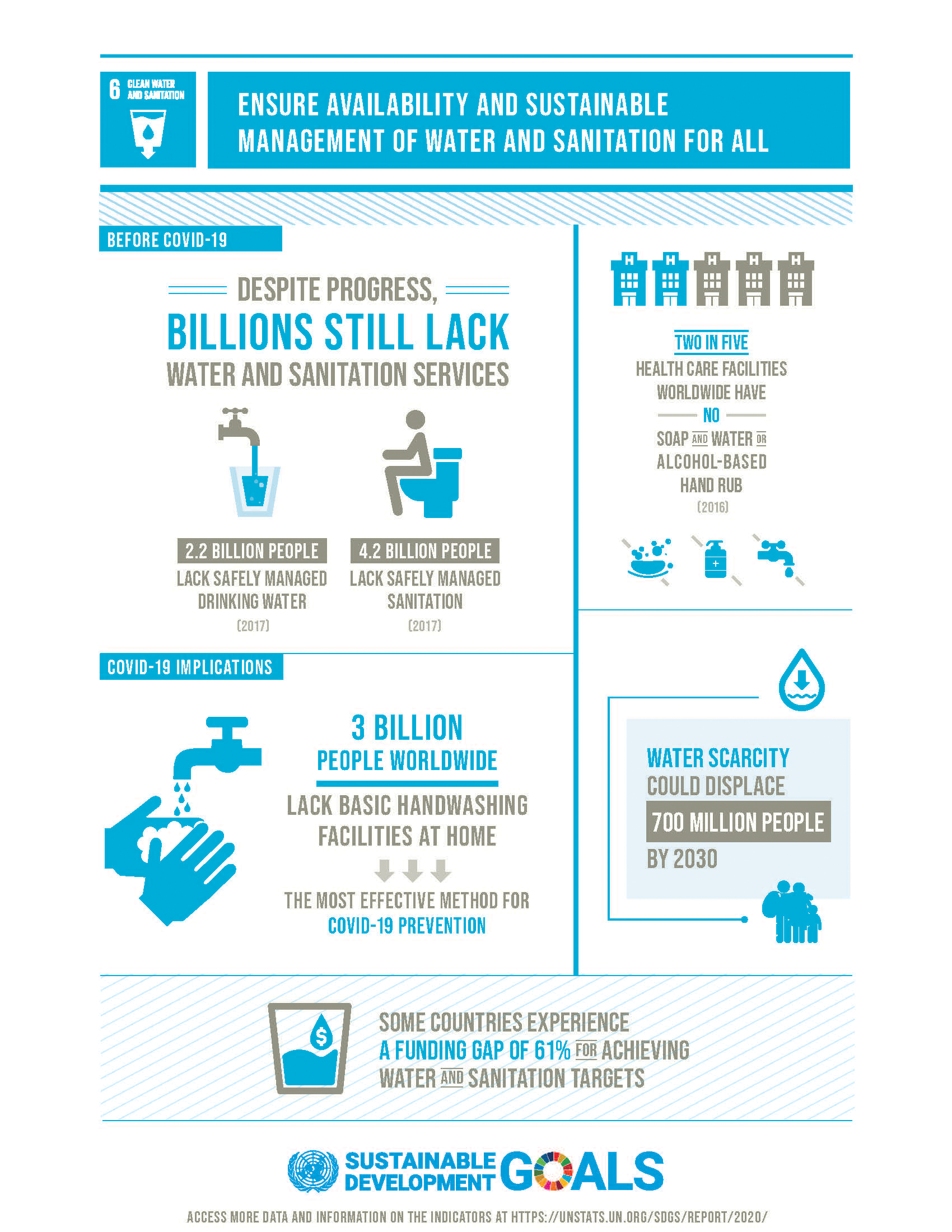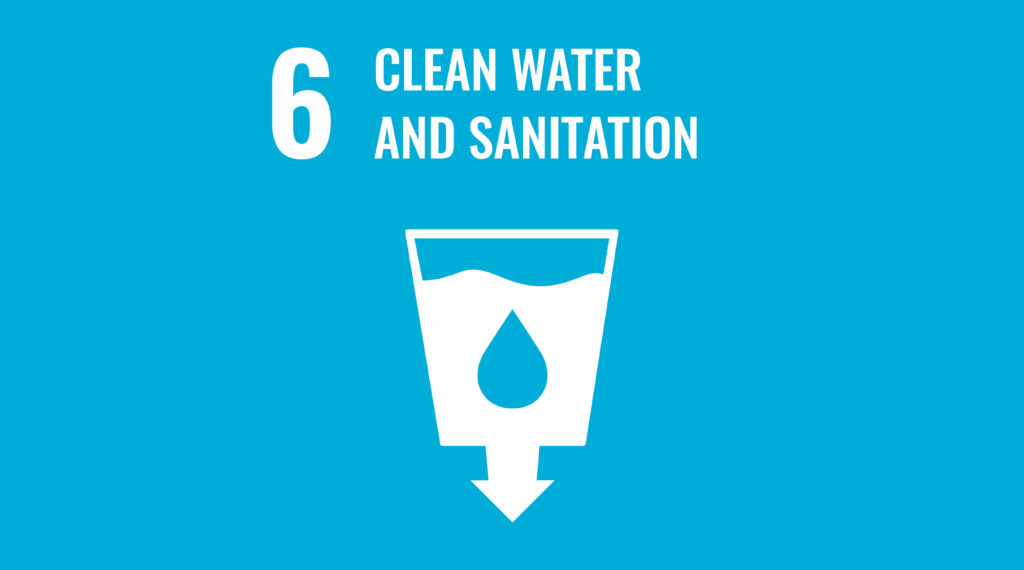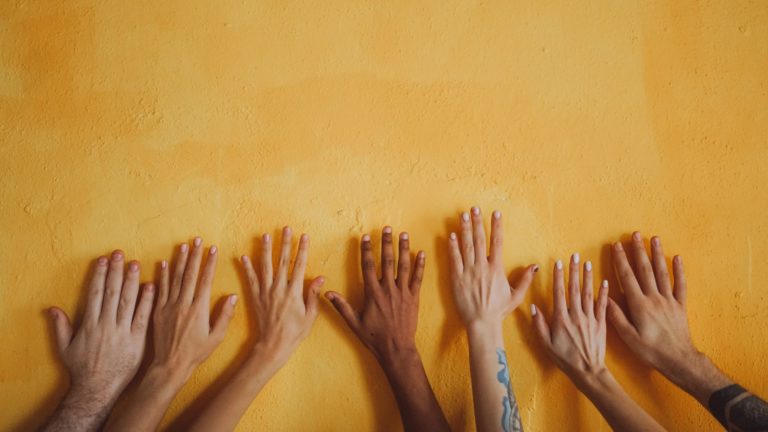Clean Water and Sanitation
While substantial progress has been made in increasing access to clean water and sanitation, billions of people—mostly in rural areas—still lack these basic services. Worldwide, one in three people do not have access to safe drinking water, two out of five people do not have a basic hand-washing facility with soap and clean water, and more than 673 million people still practice open defecation.
The COVID-19 pandemic has demonstrated the critical importance of sanitation, hygiene and adequate access to clean water for preventing and containing diseases. Hand hygiene saves lives. According to the World Health Organization, handwashing is one of the most effective actions you can take to reduce the spread of pathogens and prevent infections, including the COVID-19 virus. Yet billions of people still lack safe clean water sanitation, and funding is inadequate.
Sustainable Development Goals
The 2030 Agenda for Sustainable Development was adopted by all United Nations Member states in 2015, an agenda that provides a shared blueprint for peace and prosperity for people and the planet, now and into the future.
The 17 Sustainable Development Goals (SDGs) are an urgent call for action by all countries – developed and developing – in a global partnership. They recognize that ending poverty and other deprivations must go hand-in-hand with strategies that improve health and quality education, reduce inequality, and spur economic growth – all while tackling climate change and working to preserve our oceans and forests. Learn more about the UN SDG’s.

What’s the goal here?
To ensure access to safe water sources and sanitation for all.
Why?
Access to clean water, sanitation and hygiene is a human right. The demand for clean water has outpaced population growth, and half the world’s population is already experiencing severe water scarcity at least one month a year. Water is essential not only to health, but also to poverty reduction, food security, peace and human rights, ecosystems and education. Nevertheless, countries face growing challenges linked to clean water scarcity, water pollution, degraded water-related ecosystems and cooperation over transboundary water basins.
What are the challenges to lack of access to safe water and sanitation?
In 2017, an estimated 3 billion people worldwide lacked the ability to safely wash their hands at home – one of the cheapest, easiest and most effective ways to prevent the spread of diseases like the coronavirus. Water, sanitation and hygiene services are also not always available at medical care facilities: in 2016, one in four facilities around the world lacked basic clean water supplies, one in five had no sanitation services, and two in five had no soap and water or alcohol-based hand rub, at points of care.
And today, 4.2 billion people are still faced with daily challenges accessing even the most basic of services. Of these, 673 million people practiced open defecation. By managing our water sustainably, we are also able to better manage our production of food and energy and contribute to decent work and economic growth. Moreover, we can preserve our clean water ecosystems, their biodiversity, and take action on climate change.
Are water and climate changed linked?
Water availability is becoming less predictable in many places. In some regions, droughts are exacerbating clean water scarcity and thereby negatively impacting people’s health and productivity and threatening sustainable development and biodiversity worldwide. Ensuring that everyone has access to sustainable clean water and sanitation services is a critical climate change mitigation strategy for the years ahead. Without better infrastructure and management, millions of people will continue to die every year from water-related diseases such as malaria and diarrhoea, and there will be further losses in biodiversity and ecosystem resilience, undermining prosperity and efforts towards a more sustainable future.
What can we do?
Civil society organizations should work to keep governments accountable, invest in clean water research and development, and promote the inclusion of women, youth and indigenous communities in clean water resources governance.
Generating awareness of these roles and turning them into action will lead to win-win results and increased sustainability and integrity for both human and ecological systems.
You can also get involved in the World Water Day and World Toilet Day campaigns that aim to provide information and inspiration to take action on hygiene issues.
United Nation Sustainable Development Goals
(United Nations why it matters)
Facts and Figures
- 1 in 4 health care facilities lacks basic water services
- 3 in 10 people lack access to safely managed drinking water services and 6 in 10 people lack access to safely managed sanitation facilities.
- At least 892 million people continue to practice open defecation.
- Women and girls are responsible for water collection in 80 per cent of households without access to water on premises.
- Between 1990 and 2015, the proportion of the global population using an improved drinking water source has increased from 76 per cent to 90 per cent
- Water scarcity affects more than 40 per cent of the global population and is projected to rise. Over 1.7 billion people are currently living in river basins where water use exceeds recharge.
- 2.4 billion people lack access to basic sanitation services, such as toilets or latrines
- More than 80 per cent of wastewater resulting from human activities is discharged into rivers or sea without any pollution removal
- Each day, nearly 1,000 children die due to preventable water and sanitation-related diarrheal diseases
- Approximately 70 per cent of all water abstracted from rivers, lakes and aquifers is used for irrigation
- Floods and other water-related disasters account for 70 per cent of all deaths related to natural disasters
Goal 6 Targets
- 6.1 By 2030, achieve universal and equitable access to safe and affordable drinking water for all
- 6.2 By 2030, achieve access to adequate and equitable sanitation and hygiene for all and end open defecation, paying special attention to the needs of women and girls and those in vulnerable situations
- 6.3 By 2030, improve water quality by reducing pollution, eliminating dumping and minimizing release of hazardous chemicals and materials, halving the proportion of untreated wastewater and substantially increasing recycling and safe reuse globally
- 6.4 By 2030, substantially increase water-use efficiency across all sectors and ensure sustainable withdrawals and supply of freshwater to address water scarcity and substantially reduce the number of people suffering from water scarcity
- 6.5 By 2030, implement integrated water resources management at all levels, including through transboundary cooperation as appropriate
- 6.6 By 2020, protect and restore water-related ecosystems, including mountains, forests, wetlands, rivers, aquifers and lakes
- 6.A By 2030, expand international cooperation and capacity-building support to developing countries in water- and sanitation-related activities and programmes, including water harvesting, desalination, water efficiency, wastewater treatment, recycling and reuse technologies
- 6.B Support and strengthen the participation of local communities in improving water and sanitation management
Links
World Water Assessment Programme
UNDP Water and Ocean Governance
UN-HABITAT Water and Sanitation
A Post-2015 Global Goal for Water: Recommendations from UN-Water
Water and Sustainable Development Goals
Information briefs on water and sustainable development
UN-Water Decade Programme on Advocacy and Communication
UN Water and Sanitation Best Practices Platform
We, at AI for Good foundation, are using AI + ML initiatives in pursuit of the 17 SDGs. With various projects in progress, such as our Climate Trend Scanner and the SDG Data Catalog, we are determined to help and facilitate achieving the goals.







